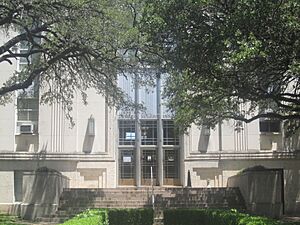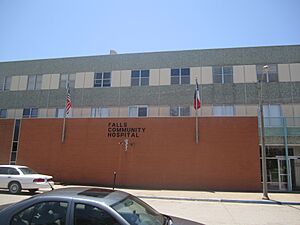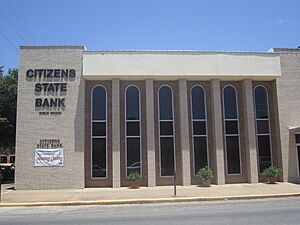Marlin, Texas facts for kids
Quick facts for kids
Marlin, Texas
|
|
|---|---|
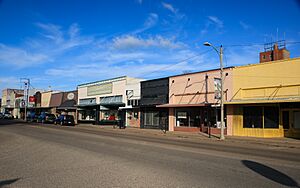
Downtown Marlin, Texas (2024)
|
|
| Nickname(s):
The Mineral Water City of Texas
|
|
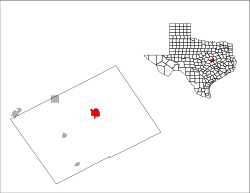
Location of Marlin, Texas
|
|
| Country | |
| State | |
| County | Falls |
| Settled | 1850 |
| Incorporated | 1867 |
| Government | |
| • Type | Council-Manager |
| Area | |
| • Total | 4.57 sq mi (11.83 km2) |
| • Land | 4.52 sq mi (11.70 km2) |
| • Water | 0.05 sq mi (0.13 km2) |
| Elevation | 394 ft (120 m) |
| Population
(2020)
|
|
| • Total | 5,462 |
| • Density | 1,235.55/sq mi (477.07/km2) |
| Demonym(s) | Marlinite |
| Time zone | UTC−6 (Central (CST)) |
| • Summer (DST) | UTC−5 (CDT) |
| ZIP Code |
76661
|
| Area code | 254 |
| FIPS code | 48-46740 |
| GNIS feature ID | 2411037 |


Marlin is a city located in Falls County, Texas, United States. In 2020, about 5,462 people lived there. Since 1851, Marlin has been the main city and county seat of Falls County. It is known as "The Hot Mineral Water City of Texas" because special mineral water was found there in 1892.
Contents
- Discover the History of Marlin, Texas
- Education in Marlin
- Marlin Sports History
- Modern Utilities and Economy
- Geography and Climate
- Transportation in Marlin
- Marlin's Population and People
- Education System
- Local Newspapers
- Culture and Filming Locations
- Notable People from Marlin
- Images for kids
- See also
Discover the History of Marlin, Texas
How Marlin Began (1851–1861)
The city of Marlin is about 4 miles east of the Brazos River. This river flows through the middle of Falls County. In 1834, a settlement called Sarahville de Viesca was started near the river.
In 1850, Falls County was created. Viesca was first chosen as the county seat. But citizens wanted to pick their own spot. So, in 1851, they voted for Adams to be the new county seat. On March 22, 1851, Adams was renamed "Town of Marlin." This was to honor John Marlin, an important early leader. The new town was built around a courthouse square. A log courthouse was built first, which also served as a school and church. In 1854, a new courthouse was built for $5,000.
By 1859, Marlin had a population of 2,875 white people and 1,225 enslaved people.
Marlin After the Civil War (1865–1877)
Marlin officially became a city on January 12, 1867. Two formerly enslaved people, Nelson Denson and Lige Moore, became elected officials. The Houston & Texas Central Railway reached Marlin in 1871. This train line helped the city grow. A new business area developed near the train station.
In 1875, the old courthouse burned down. A new brick courthouse was built. This courthouse was damaged in a storm in 1886. A new one was then designed by architect Eugene T. Heiner.
The Mineral Water Era (1890s–1960s)
In 1891, the city of Marlin drilled a well. They accidentally found hot mineral water. People believed this water had healing powers. The first bathhouse was built in 1895. Many more followed. Some bathhouses had large swimming pools. Others had private bathing areas with marble tubs. Thousands of people came to Marlin to "take the cure."
Marlin had several small hotels. In 1895, the three-story Arlington Hotel was built. This showed how important the mineral water industry was. The hotel and a bathhouse burned down in 1899. But they were rebuilt even grander in 1901. The new Arlington Hotel hosted many important events. Other hotels like the Fannin, Majestic, and Imperial also opened. Most were near the public hot water fountain.
In 1929, Conrad Hilton started building a Hilton Hotel. It opened in 1930 and cost $375,000. Marlin citizens helped pay for it. This nine-floor, 110-room hotel is still the tallest building in Marlin. It was connected to a bathhouse by a tunnel. Mr. Hilton later sold this hotel. It was then known as the Falls Hotel. It closed as a hotel in the late 1960s. Parts of the first floor have been used by small businesses. The hotel building is still standing today.
After World War II, the mineral water industry slowed down. Many bathhouse businesses closed. Most were gone by the late 1960s. There were a few attempts to bring the industry back, but they didn't last. Today, you can sometimes get hot mineral water from a fountain. It is outside the Marlin Chamber of Commerce. The water is still there, and some wells are active. The local Falls Community Hospital uses the mineral water to heat its building.
The Falls County Historical Commission has a museum. Next to it is the Palace Theatre. This group puts on plays and shows for the community.
Education in Marlin
Early Schools in Marlin
The first schools in Falls County were private schools in Marlin. The Marlin Male and Female Academy opened in 1871. It was later destroyed by fire. A new public brick school was built in 1903. A high school was finished in 1917. The Marlin Independent School District started in 1923.
Schools for African Americans were also organized in 1875. These schools met in churches. In 1916, the city decided to build a school for Black students. Booker T. Washington High School was built in 1951. It is still standing but is empty. In 1968, the two school districts joined together.
Modern School Challenges
In 2023, a high school graduation ceremony was postponed. This happened because many students did not meet the requirements to graduate. Only 5 out of 33 students were eligible. The school district said students must meet high standards. This includes attendance and grades. The superintendent checked student files. He found that many students had failing grades or attendance issues.
Marlin Sports History
Baseball Spring Training in Marlin (1904–1918)
Marlin was a popular place for Major League Baseball teams to train. It had a mild climate and hot mineral water baths. It was also easy to reach by train. Four different teams trained in Marlin:
- Chicago White Sox (1904)
- St. Louis Cardinals (1905)
- Cincinnati Reds (1906–1907)
- New York Giants (1908–1918)
Players stayed at the Arlington Hotel. The hot mineral water baths were part of their daily routine. They believed the baths helped them stay in shape.
Marlin also had its own minor league baseball teams. These included the Marlin Marlins (1916–1917) and the Marlin Bathers (1923–1925).
Modern Utilities and Economy
Telephones came to Marlin homes in 1900. Cars, electricity, and natural gas followed soon after. By the mid-1900s, Marlin had many businesses. These included a bottling company, a brickyard, and a turkey-processing plant.
Economic Changes in the 2000s
In the late 1900s and early 2000s, Marlin lost many big employers. This caused the city's population to shrink. The Swift turkey-processing plant closed. Marlin Mills, a carpet company, also closed. A styrofoam company caught fire and was torn down. A dress-making plant closed. Wallace, a printing company, closed in the mid-2000s.
The Thomas T. Connally Veterans Affairs Hospital closed in 2005. This meant over 100 jobs were lost. This made the economy in Marlin even weaker.
New investments have happened. A three-story, 60-room Best Western Hotel was built. There were plans for a medical facility for prisoners. But these plans did not happen.
City Improvements in 2011
In 2011, Marlin received money to remove 15 old buildings. Over 6 miles of new water lines were built. The city also completed a large water tower project.
The city brought back its Annual Music and Blues Festival in 2011. Money was raised to fix the city baseball fields. The City Little League was restarted, attracting many children. The city's crime rate also went down by 45% that year.
Water Issues in 2015
In December 2015, a protest happened because the city's water was turned off for almost a week. The water system had problems. A city worker had turned off alarms instead of fixing issues. This led to a city-wide water crisis.
New Leadership in 2019
On May 4, 2019, Carolyn Lofton became the first Black woman elected as mayor of Marlin. She wanted to improve the community for everyone.
Geography and Climate
Marlin is in the middle of Falls County. It is located at 31°18′29″N 96°53′35″W / 31.30806°N 96.89306°W. Texas State Highway 6 runs along the eastern side of the city. This highway goes to Waco and Bryan. Texas State Highway 7 goes through the center of town.
The city covers about 11.8 square kilometers (4.57 square miles). Most of this is land.
Marlin's Weather
Marlin has hot, humid summers. Winters are usually mild to cool. This type of weather is called a humid subtropical climate.
| Climate data for Marlin, Texas (1991–2020 normals, extremes 1902–1905, 1944–2016) | |||||||||||||
|---|---|---|---|---|---|---|---|---|---|---|---|---|---|
| Month | Jan | Feb | Mar | Apr | May | Jun | Jul | Aug | Sep | Oct | Nov | Dec | Year |
| Record high °F (°C) | 88 (31) |
98 (37) |
98 (37) |
102 (39) |
103 (39) |
105 (41) |
110 (43) |
112 (44) |
109 (43) |
100 (38) |
90 (32) |
86 (30) |
112 (44) |
| Mean daily maximum °F (°C) | 59.1 (15.1) |
63.0 (17.2) |
69.3 (20.7) |
76.9 (24.9) |
83.4 (28.6) |
90.6 (32.6) |
94.5 (34.7) |
95.5 (35.3) |
89.8 (32.1) |
80.6 (27.0) |
69.4 (20.8) |
60.8 (16.0) |
77.7 (25.4) |
| Daily mean °F (°C) | 46.3 (7.9) |
50.2 (10.1) |
56.9 (13.8) |
64.5 (18.1) |
72.2 (22.3) |
79.5 (26.4) |
82.9 (28.3) |
83.1 (28.4) |
76.9 (24.9) |
67.3 (19.6) |
55.8 (13.2) |
47.9 (8.8) |
65.3 (18.5) |
| Mean daily minimum °F (°C) | 33.5 (0.8) |
37.4 (3.0) |
44.5 (6.9) |
52.1 (11.2) |
61.0 (16.1) |
68.3 (20.2) |
71.3 (21.8) |
70.7 (21.5) |
64.1 (17.8) |
53.9 (12.2) |
42.1 (5.6) |
35.0 (1.7) |
52.8 (11.6) |
| Record low °F (°C) | −7 (−22) |
5 (−15) |
15 (−9) |
29 (−2) |
33 (1) |
43 (6) |
52 (11) |
36 (2) |
41 (5) |
25 (−4) |
15 (−9) |
6 (−14) |
−7 (−22) |
| Average precipitation inches (mm) | 3.32 (84) |
2.87 (73) |
3.74 (95) |
3.35 (85) |
4.97 (126) |
3.01 (76) |
1.84 (47) |
2.23 (57) |
3.05 (77) |
4.34 (110) |
2.94 (75) |
3.44 (87) |
39.10 (993) |
| Average precipitation days (≥ 0.01 in) | 6.9 | 6.9 | 8.0 | 6.2 | 7.7 | 6.2 | 3.8 | 3.4 | 5.2 | 6.3 | 6.5 | 7.3 | 74.4 |
| Source: NOAA | |||||||||||||
Transportation in Marlin
Highways and Roads
- Texas State Highway 6
- Texas State Highway 7
- Farm-to-market road 147
Airport Access
Marlin has its own airport, the Marlin Municipal Airport. It is about 4 miles northeast of the city center.
Marlin's Population and People
| Historical population | |||
|---|---|---|---|
| Census | Pop. | %± | |
| 1870 | 500 | — | |
| 1880 | 1,500 | 200.0% | |
| 1890 | 2,058 | 37.2% | |
| 1900 | 3,092 | 50.2% | |
| 1910 | 3,878 | 25.4% | |
| 1920 | 4,310 | 11.1% | |
| 1930 | 5,338 | 23.9% | |
| 1940 | 6,542 | 22.6% | |
| 1950 | 7,099 | 8.5% | |
| 1960 | 6,918 | −2.5% | |
| 1970 | 6,351 | −8.2% | |
| 1980 | 7,099 | 11.8% | |
| 1990 | 6,386 | −10.0% | |
| 2000 | 6,628 | 3.8% | |
| 2010 | 5,967 | −10.0% | |
| 2020 | 5,462 | −8.5% | |
| U.S. Decennial Census | |||
| Race | Number | Percentage |
|---|---|---|
| White (NH) | 1,530 | 28.01% |
| Black or African American (NH) | 2,320 | 42.48% |
| Native American or Alaska Native (NH) | 16 | 0.29% |
| Asian (NH) | 23 | 0.42% |
| Pacific Islander (NH) | 3 | 0.05% |
| Some other race (NH) | 3 | 0.05% |
| Mixed/multiracial (NH) | 146 | 2.67% |
| Hispanic or Latino | 1,421 | 26.02% |
| Total | 5,462 |
In 2020, Marlin had 5,462 people living in the city. There were 1,889 households.
In 2000, there were 6,628 people. About 30.2% of households had children under 18. About 35.7% were married couples. The average household had 2.47 people. The average family had 3.21 people.
The age breakdown in 2000 was:
- 33.2% under 18
- 7.4% from 18 to 24
- 21.3% from 25 to 44
- 18.9% from 45 to 64
- 19.3% were 65 or older.
The average age was 35 years.
The median income for a household was $21,443. For a family, it was $26,861. About 31.3% of the population lived below the poverty line.
Education System
The Marlin Independent School District serves the city of Marlin.
Local Newspapers
Marlin has had several newspapers. The Marlin Democrat has been serving the city since 1890. It is published every Wednesday. Other newspapers included The Falls County Freeman, which served the African-American community. The Marlin Ball and The Falls County Record were also popular. Today, The Marlin Democrat is one of the active newspapers in Falls County.
Culture and Filming Locations
Marlin has been a filming location for movies and TV shows:
- Leadbelly (1976): This movie was filmed in 1974.
- Infamous (2006): Parts of this movie were filmed around the Falls County Courthouse.
- Making New Family Memories in Rural Texas (2016): This TV show episode was filmed in Marlin.
Notable People from Marlin
Many interesting people have connections to Marlin:
- Danario Alexander: A wide receiver for the San Diego Chargers.
- Ken "Coach" Carter: Opened a special boarding school in town.
- Tom Connally: A U.S. senator and member of the U.S. House of Representatives.
- Bruce Curry: A world champion boxer.
- Bobbi Humphrey: A jazz flautist and singer.
- Blind Willie Johnson: A famous blues and gospel street musician.
- Dan Kubiak: A state representative.
- Curtis Modkins: A football coach for the Chicago Bears.
- Bob (Robert Jasper) Reeves: A Western movie actor.
- LaDainian Tomlinson: A great San Diego Chargers and New York Jets running back.
- Phil Wellman: A minor league baseball player and manager.
Images for kids
See also
 In Spanish: Marlin (Texas) para niños
In Spanish: Marlin (Texas) para niños



